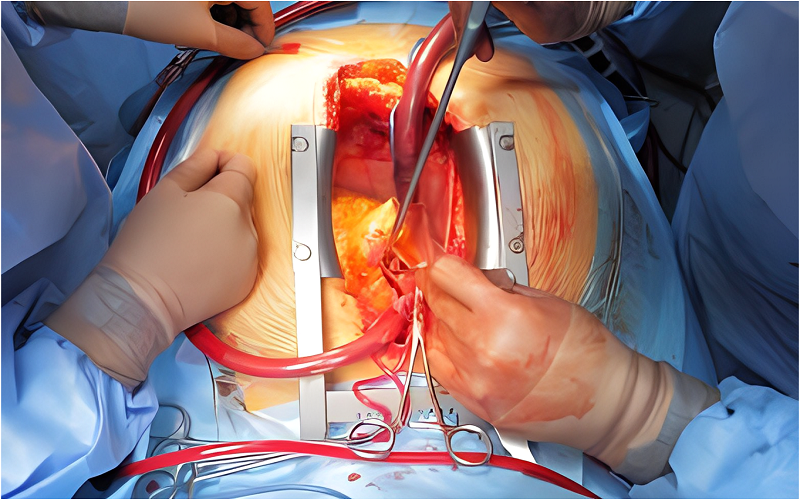Advancements in AI-powered imaging and guidance are revolutionizing spinal surgery, providing surgeons with real-time visualization and unparalleled precision, particularly in disc replacement procedures. This cutting-edge technology enables surgeons to make immediate adjustments and utilize high-resolution imaging for a clearer, more detailed view of the spine. Dr. Larry Davidson, a proponent of innovative surgical solutions, highlights how AI enhances accuracy, minimizes risks and improves outcomes, resulting in the potential for safer procedures and faster patient recovery.
The Role of AI-Powered Imaging in Spinal Surger
AI-powered imaging creates detailed 3D models of the patient’s spine during the preoperative phase, helping surgeons assess factors like spinal alignment, disc degeneration and nearby structures. Through these images, surgeons gain a clearer understanding of the spine’s unique structure both before and during surgery, allowing for better decision-making. AI-powered imaging creates detailed 3D models of the patient’s spine during the preoperative phase, enabling surgeons to assess factors like spinal alignment, disc degeneration and nearby structures. These comprehensive models support meticulous planning and provide a roadmap for the procedure so surgeons can anticipate any challenges and plan for precise disc placement.
AI enhances image processing, allowing for the analysis of MRI, CT and X-ray scans to detect subtle changes in bone density, disc height and nerve pathways that might otherwise go unnoticed. This depth of data supports precise surgical planning, helping predict potential obstacles during the operation.
Real-Time Guidance and Intraoperative Imaging
AI-powered imaging tools offer continuous imaging throughout surgery, allowing surgeons to make real-time adjustments and monitor positioning with live feedback. This real-time guidance reduces the risk of misalignment, ensuring the artificial disc is correctly positioned, even in patients with complex spinal anatomy. Instead of relying on visual estimates alone, surgeons have immediate feedback that allows them to make necessary adjustments instantly, leading to improved surgical accuracy and reliable outcomes. Real-time imaging helps minimize the need for visual approximation, assisting in tracking both instrument placement and disc alignment to improve precision.
Additionally, intraoperative AI guidance systems enhance navigation by overlaying 3D images onto the surgical site, almost like augmented reality. This technology allows the surgeon to “see through” tissues to visualize critical areas such as nerves, blood vessels and bones, helping to make safer, more informed decisions during surgery. With a clear understanding of anatomy, surgeons can make more targeted incisions, allowing for a minimally invasive approach and a smoother recovery process.
Key Benefits of AI-Powered Imaging in Spinal Disc Replacement
One of the primary advantages of AI-driven imaging in spinal disc replacement is improved accuracy in disc placement, which is crucial for maintaining spinal alignment and function. With AI guidance, surgeons can place the disc with optimal precision, which reduces the likelihood of complications and supports natural spinal movement. Proper alignment also minimizes stress on surrounding discs, helping to reduce the need for future corrective surgeries. AI imaging may help support consistent and precise outcomes across various cases, even in complex spinal surgeries. AI-powered imaging also shortens surgical time, as the continuous guidance streamlines the procedure by reducing the need for repeated adjustments. Faster surgical times lower infection risks, decrease surgeon fatigue and contribute to a more focused and efficient operation. With less time spent reevaluating positioning, surgeons can rely on AI’s precise tracking to guide them throughout the surgery.
AI imaging may help reduce the risk of complications by providing clearer visuals of potential issues, allowing surgeons to avoid sensitive structures like nerves and surrounding tissues. Real-time guidance helps protect these areas, reducing the likelihood of nerve injury or postoperative complications. Additionally, by providing a constant visual map, AI imaging reduces the mental load on surgeons like Dr. Larry Davidson, allowing them to focus more fully on precise movements. With fewer errors related to manual positioning, AI imaging contributes to a safer environment for the patient, supporting a successful outcome.
The reduced risk of complications often leads to better patient satisfaction and recovery, as AI-enabled accuracy ensures precise disc placement and minimizes unnecessary tissue disruption. Patients generally experience less postoperative pain and shorter recovery times, allowing them to begin physical therapy sooner and return to their normal routines faster. As a result, AI-powered imaging provides benefits that enhance the overall quality of life post-surgery as patients recover with reduced pain and improved mobility.
Future Potential of AI in Spinal Surgery
As AI technology advances, its role in spinal surgery is likely to expand further. One area of growth is AI-driven predictive modeling, which may help anticipate patient-specific spinal changes and potential complications. This predictive ability would allow for highly tailored preoperative plans that account for individual anatomical variations, leading to more customized care.
Additionally, machine learning algorithms can be used to continuously improve surgical techniques and enhance accuracy by analyzing data from past surgeries. By refining recommendations based on successful outcomes, these systems will support surgeons with evolving insights and best practices. Combining AI imaging with robotic-assisted surgery could offer additional benefits, as robotics may provide finer control over positioning and instrument movement, potentially enhancing precision. AI-guided robotics would improve disc placement accuracy, optimizing both immediate surgical success and long-term outcomes.
In addition, AI systems may become more adept at predicting patient recovery trajectories, allowing for even more personalized post-operative care plans. This level of individualized planning could reduce complications, shorten recovery times and improve overall patient satisfaction. As AI continues to integrate with surgical robotics and predictive analytics, the potential for truly personalized spinal surgery will become more achievable.AI-powered imaging and guidance in spinal disc replacement bring substantial improvements in surgical precision, patient safety and procedural efficiency. By enabling real-time adjustments, enhancing safety and reducing recovery times, AI imaging offers patients and surgeons a potentially more reliable path to successful spinal disc replacement. As AI continues to evolve and integrate further into spinal care, its potential to support a precision-focused, patient-centered approach to spinal surgery is likely to grow, possibly making disc replacement safer and more effective for many patients.



